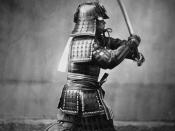Legacy of the Samurai
The characteristics, philosophy,
and history of the samurai.
For seven centuries, the samurai ruled Japan as the powerful warrior class. As a class of warriors and knights, they led society in feudal Japan. The loyalty to his lord was much more important than his allegiance to his friends, family and even the emperor. Their philosophy was one liberated him from fear, and for these reasons, the samurai came to be the dominate force throughout medieval Japan.
War played a central part in the history of Japanese samurai. As regional clans gathered manpower, resources and struck alliances with each other, they formed a hierarchy centered around a toryo, or chief. This chief was typically a relative of the emperor and a member of one of the two dominating clan families of the pre-samurai era. Though they were originally sent to regional areas for a fixed four year term as a magistrate, the toryo usually declined to return to the capital when their terms ended.
Their sons inherited their positions instead and continued to lead the clans in suppressing rebellion throughout Japan during the middle and later Heian period. (Cook 24) One main reason why conflict between clans was so predominant was because they were typically started as a result of land ownership. Only a fifth of Japan's land was suitable for agriculture. The struggle for control of land eventually gave rise to the samurai class.
The samurai eventually became a class unto themselves between the 9th and 12th centuries A.D. They were called by two names: samurai which means "knights" and bushi which means "warriors". The samurai came from guards of the imperial palace and from private guards that the clans employed. They also acted as a police force in and around Kyoto. These forerunners of what...



A very well researched paper
I'd like to applaud you on writing this paper on the Legacy of the Samurai's. Not only is it informative, but is also a very good read.
I've learned several new things from reading your paper.
However, I'd like to mention that you should have spent a bit of time formatting your paper so that it's more pleasant on the eyes, eg, "Justify" your paper, instead of "align left".
0 out of 0 people found this comment useful.